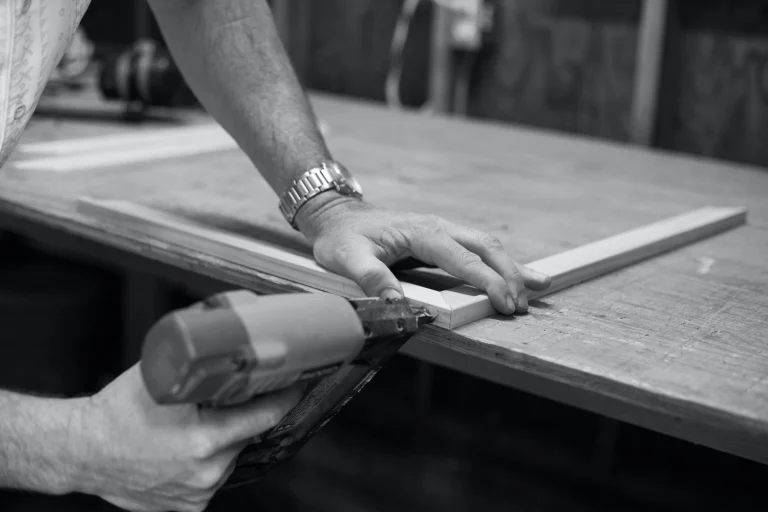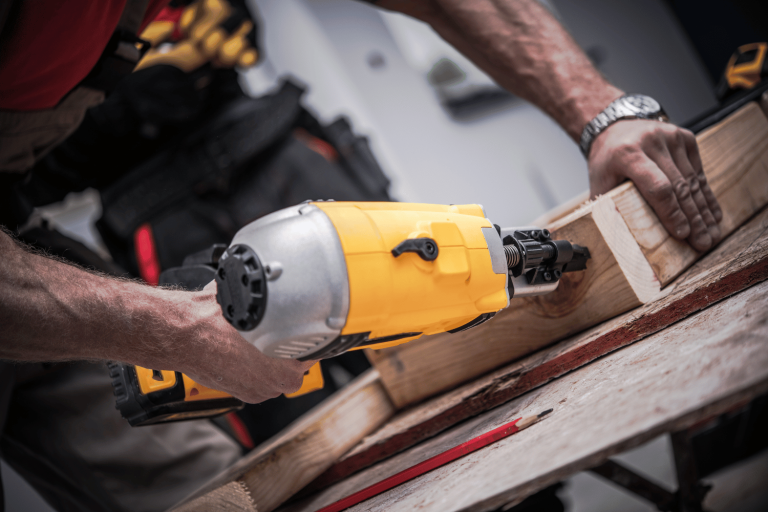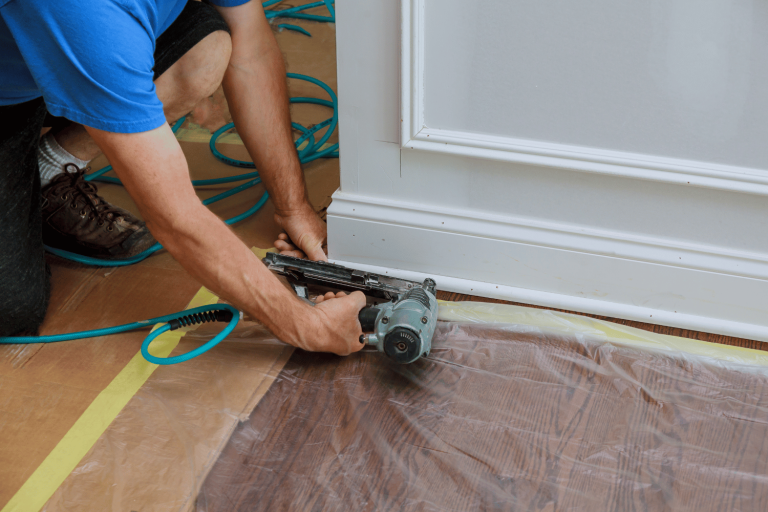Demystifying the Framing Nailer: What You Need to Know
If you’re someone who likes to have complete control over your DIY or construction projects, then understanding the ins and outs of a framing nailer is crucial. Demystifying the framing nailer will give you the knowledge you need to confidently tackle any project that requires this powerful tool.
A framing nailer is an essential piece of equipment used in carpentry, woodworking, and general construction. It is designed to drive nails into various materials quickly and efficiently, saving you valuable time and effort. With its high-powered pneumatic or cordless operation, a framing nailer can handle heavy-duty tasks such as building walls, constructing decks, or installing roof trusses.
In this article, we will delve into the different types of framing nailers available on the market today. We will explore their uses in detail so that you can identify which type best suits your specific needs. Additionally, we’ll guide you through selecting the right framing nailer for your project based on factors like power source options, size and weight considerations, and magazine capacity.
By demystifying the framing nailer and providing you with all the necessary information about its types and uses, we aim to empower you with complete control over your next construction venture.
Key Takeaways
- Framing nailers are essential tools for DIY and construction projects, providing time and effort savings compared to traditional hammering methods.
- There are different types of framing nailers available, including pneumatic, electric, and cordless models, each with their own advantages and disadvantages.
- Framing nailers are commonly used in construction and carpentry projects for tasks like building walls, installing joists, and assembling furniture pieces.
- When choosing a framing nailer, it is important to consider specific project requirements, budget considerations, and evaluate user reviews and expert recommendations to make an informed decision.
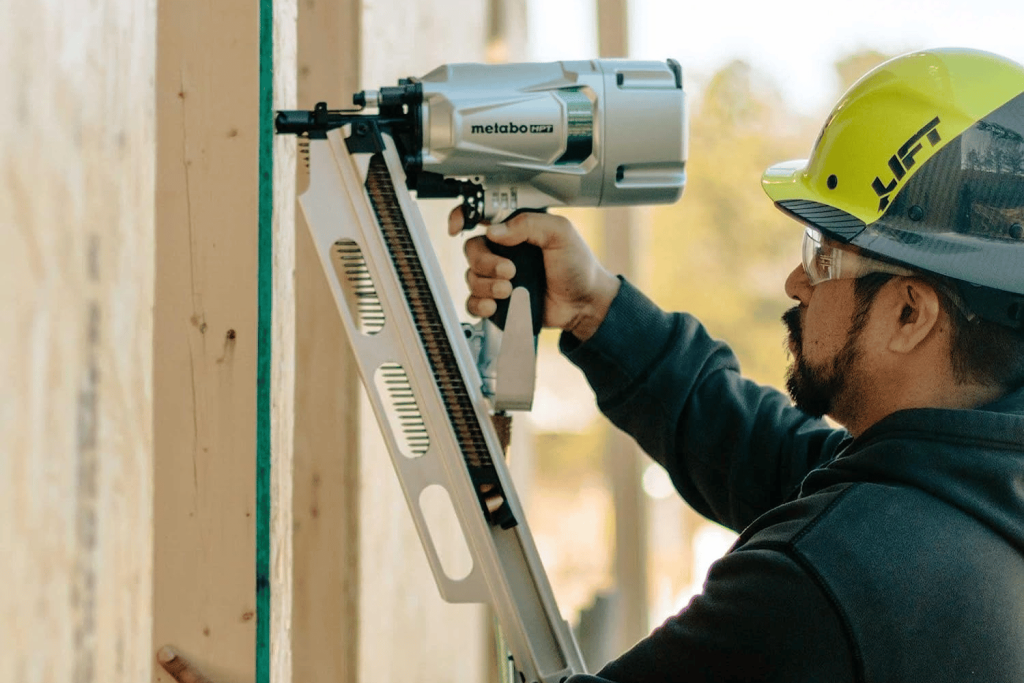
Understanding Framing Nailers
When it comes to understanding framing nailers, there are a few key points to keep in mind.
First, framing nailers are powerful tools specifically designed for driving large nails into wood or other materials. They’re commonly used in construction projects where strong and secure connections are needed.
Second, there are different types of framing nailers available, including pneumatic (air-powered), electric, and cordless models. Each type has its own advantages and considerations depending on the job requirements.
Finally, it’s important to be familiar with the key components and terminology of a framing nailer. These include the magazine (which holds the nails), nail collation (the way the nails are arranged), and depth adjustment (allowing you to control how deeply the nails penetrate).
Having a good understanding of these aspects will help you use a framing nailer effectively and safely.
Definition and purpose of framing nailers
Framing nailers, with their powerful pneumatic action and precision, are the go-to tools for professional carpenters when constructing sturdy wooden frames. A framing nailer is a type of nail gun that’s specifically designed to drive nails into wood quickly and efficiently.
It is commonly used in construction projects such as building houses, installing decks, or framing walls. The main purpose of a framing nailer is to securely attach pieces of wood together using nails. These tools can easily handle large volumes of work and make the process of installing nails much faster compared to traditional hammering methods.
Framing nailers typically use a specific type of nail called a ‘framing nail’ that has a large head and thick shank to provide maximum holding power. With a framing nailer in hand, you have complete control over the speed and accuracy of driving nails, making it an essential tool for any serious carpenter’s arsenal.
Different types of framing nailers
Discover the diverse array of framing nailers available on the market and unleash your creativity with endless possibilities for your woodworking projects.
When it comes to framing nailers, there are several different types that you can choose from:
- Pneumatic Framing Nailer: This type of framing nailer uses compressed air to drive nails into wood. It offers high power and efficiency, making it a popular choice among carpenters.
- Cordless Framing Nailer: As the name suggests, this type of framing nailer is battery-powered and doesn’t require an external power source. It provides the freedom of movement and eliminates the need for hoses or cables.
- finish nailer: Although not a traditional framing nailer, a finish nailer is worth mentioning as it’s commonly used in conjunction with a framing nailer. It’s designed for more delicate woodworking projects where appearance matters, such as trim work or cabinetry.
Remember to consult your local building code regulations when choosing the appropriate nails per inch for your specific project.
With these options at your disposal, you can confidently tackle any woodworking or construction task with precision and control.
Key components and terminology
Get ready to explore the key components and terminology of a framing nailer, so you can confidently navigate your woodworking projects like a pro. Understanding these essential elements will empower you with the knowledge to tackle any task effortlessly.
The first crucial component is the magazine, which holds the nails in place for quick and efficient firing. Depending on the type of nailer, it may use either a strip or coil magazine.
Another important term to grasp is nail collation, which refers to how the nails are organized within the magazine. Collation types include paper-collated, plastic-collated, or wire-collated nails.
Lastly, we have depth adjustment – a feature that allows you to control how deep the nails penetrate into your workpiece.
By familiarizing yourself with these key components and understanding their terminology, you’ll be well-equipped to handle any framing nailer project with ease and precision.
Uses of Framing Nailers
When it comes to framing applications in construction, a framing nailer is an essential tool for building walls, installing joists, and roof framing. The power and efficiency of a framing nailer make these tasks quicker and more precise than traditional manual methods.
Additionally, beyond construction projects, framing nailers are also commonly used in carpentry and woodworking projects. They are used for tasks such as furniture assembly or fence installation.
Framing applications in construction
Explore the endless possibilities of a framing nailer as you effortlessly build walls, install joists, and frame roofs like a seasoned construction pro.
A framing nailer is an essential power tool for construction projects that require large nails to securely fasten materials together. Whether you’re installing wood paneling or constructing a new building, this versatile tool allows for precise and efficient work.
When it comes to building walls, a framing nailer can quickly drive long nails into studs and plates, ensuring sturdy connections. Installing joists becomes a breeze as the powerful tool effortlessly secures them in place with ease. Roof framing is made simpler with the framing nailer’s ability to fasten trusses and rafters securely.
Gone are the days of manually hammering each individual nail. With a framing nailer by your side, you have complete control over your construction projects while saving time and effort.
So grab your trusty framing nailer and conquer any task that requires strong and reliable fasteners!
Other applications in carpentry and woodworking projects
Now that we’ve explored the framing applications of a framing nailer in construction, let’s delve into its other versatile uses in carpentry and woodworking projects.
The framing nailer is not limited to just building walls, installing joists, or roof framing; it can be an invaluable tool for a wide range of applications. In carpentry, this powerful tool can effortlessly attach trim boards, baseboards, and crown molding with precision and speed.
When it comes to woodworking projects, the framing nailer can assist in assembling furniture pieces like cabinets or bookshelves by securely fastening joints and panels. Additionally, it can be used for constructing outdoor structures such as decks or pergolas.
With its ability to handle different types of materials and sizes of nails, the framing nailer truly proves itself as an essential tool across various carpentry and woodworking projects. So whether you’re tackling home improvement tasks or professional woodworking ventures, the versatility of the framing nailer will undoubtedly simplify your projects while ensuring sturdy and reliable results.
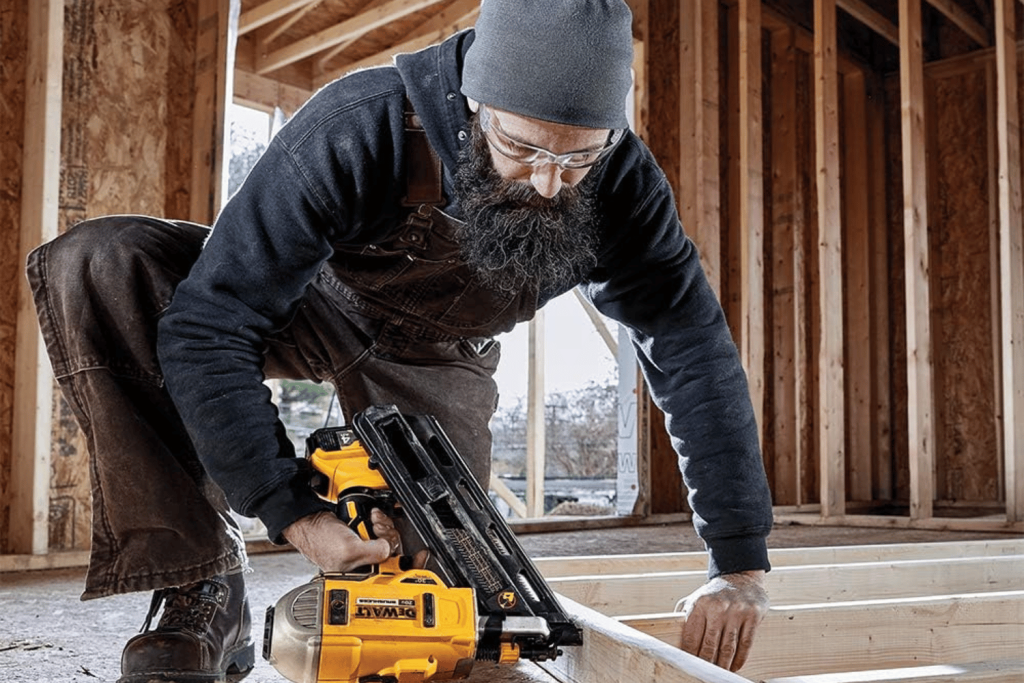
Types of Framing Nailers: Pneumatic Nailer Vs Cordless Nailer
When it comes to framing nailers, there are two main types that you need to know about: pneumatic and cordless.
Pneumatic framing nailers are powered by compressed air and require an air compressor to operate. They’re known for their power and durability, making them a popular choice among professionals.
On the other hand, cordless framing nailers are battery-powered and offer more mobility and flexibility on the job site. They provide convenience without sacrificing performance, allowing you to work in tight spaces or areas without access to electricity.
Each type has its own advantages and considerations, so understanding their differences is essential when choosing the right tool for your needs.
Pneumatic framing nailers
When it comes to pneumatic framing nailers, there are several key points you need to know. Firstly, understanding the features and benefits of these tools is crucial for making an informed decision.
Secondly, knowing the pros and cons will help you weigh the advantages against any potential drawbacks.
Lastly, following best practices for using pneumatic framing nailers will ensure optimal performance and safety.
Features and benefits
Discover the incredible features and benefits of the framing nailer that will revolutionize your construction projects. With a framing nailer, you can effortlessly drive the nails into wood, saving time and effort. The compressed air-powered tool ensures precise placement of nails, reducing the risk of damaging materials. Whether you’re installing trim or working on a large-scale construction project, a framing nailer provides unparalleled control and efficiency. Consider choosing between a cordless framing nailer or finish nailer based on your specific needs.
Pros and cons
The framing nailer offers incredible features and benefits, but it’s important to weigh the pros and cons before making your decision.
One of the main advantages is its ability to drive nails into wood quickly and efficiently, saving you time and effort.
However, keep in mind that a framing nailer requires an air compressor to function properly, adding extra cost and maintenance.
Additionally, consider the power of a framing nailer as it determines the size and number of nails it can handle.
Best practices for pneumatic framing nailers
Mastering the best practices for pneumatic framing nailers will elevate your woodworking skills and allow you to effortlessly create sturdy structures.
When using a pneumatic framing nailer, it’s important to always wear safety goggles and gloves.
Before starting, make sure the compressor is set to the correct pressure for your specific nailer.
Additionally, regularly inspect and clean your nailer to maintain optimal performance.
Following these best practices will help you achieve professional results in your woodworking projects.
Cordless framing nailers
When it comes to cordless framing nailers, there are several key points you need to consider. First, let’s talk about the features and benefits of these tools.
Cordless framing nailers offer the convenience of mobility and portability, allowing you to work in tight spaces without being restricted by cords or hoses. They’re also typically lighter than their pneumatic counterparts, reducing fatigue during long hours of use.
Next, let’s discuss the pros and cons of cordless framing nailers. One major advantage is their versatility – they can be used for a variety of applications, from framing to decking and more. Additionally, they eliminate the need for an air compressor or hose, making them ideal for remote job sites or areas without access to electricity. However, one drawback is that cordless models may have less power compared to pneumatic ones and require regular battery recharging.
Let’s delve into the best practices for using cordless framing nailers. It’s important to choose a model with sufficient power and battery life based on your specific needs. Regular maintenance such as cleaning and lubricating will ensure optimal performance and longevity of your tool. Additionally, always follow safety guidelines including wearing appropriate protective gear and keeping your hands clear of the firing area when operating a cordless framing nailer.
Features and benefits
Get a grip on the power and precision of a framing nailer, and experience the ease and efficiency it brings to your construction projects.
A framing nailer is a powerful tool that offers several features and benefits. It allows for quick and accurate nailing, saving you time and effort. With adjustable depth settings, you have control over the depth of each nail. Additionally, some framing nailers offer anti-dry fire mechanisms to prevent damage to the tool or work surface.
Pros and cons
Take advantage of a framing nailer’s power and precision, but be aware of the pros and cons before making your decision. A framing nailer is a versatile tool that can handle fastening large pieces with ease. However, it may not be suitable for delicate finish work like a finish nailer. Skilled carpenters appreciate its speed and efficiency, but beginners may find it challenging to control. Consider the following table for a clearer understanding:
| Pros | Cons |
|---|---|
| Powerful and efficient | Not suitable for finish work |
| Saves time | Requires skill to control |
| Versatile | Can cause damage if misused |
| Ideal for large projects | Expensive compared to others |
| Reduces physical strain | Noisier than other options |
Best practices for cordless framing nailers
To maximize your efficiency and freedom of movement, make sure to follow these best practices when using a cordless framing nailer:
- Always wear safety goggles and gloves for protection.
- Keep the tool clean and well-maintained to ensure optimal performance.
- Use the correct size and type of nails for the job to prevent jamming or damage.
By adhering to these guidelines, you can confidently use your cordless framing nailer in any relevant context, ensuring smooth operation and accurate results.
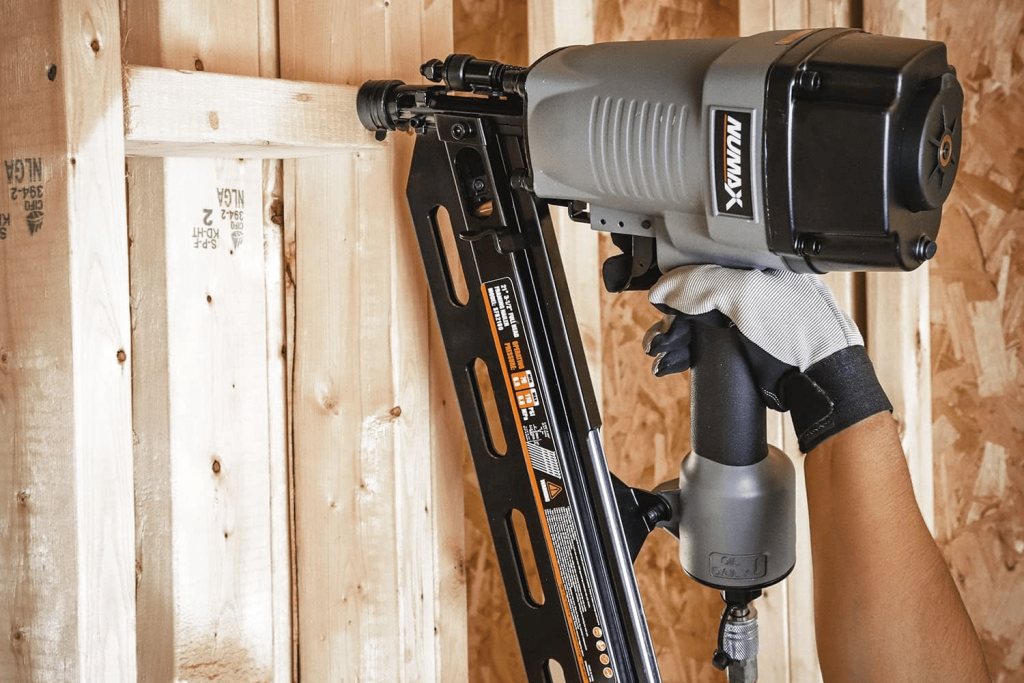
Choosing the Right Framing Nailer
When choosing the right framing nailer for your project, there are several key considerations to keep in mind.
Firstly, you need to think about the specific requirements of your project such as the nail size, depth, and power source.
Secondly, budget considerations and cost-effectiveness should also be taken into account to ensure you get the best value for your money.
Lastly, it’s important to evaluate user reviews and expert recommendations to gather insights from experienced professionals in order to make an informed decision.
Considerations based on project requirements
Using a framing nailer for various projects requires careful consideration of factors such as the appropriate nail size, desired depth, and the most suitable power source.
When it comes to nail size, it’s crucial to choose the right one based on the thickness of the materials you’re working with. For lighter applications, a smaller gauge nail may be sufficient, while heavier-duty projects may require larger gauge nails for added strength and stability.
Depth adjustment is another important feature to consider. It allows you to control how far the nails are driven into the material, ensuring that your project remains structurally sound without causing any damage or splitting.
Lastly, selecting the appropriate power source is essential for convenience and efficiency. While pneumatic framing nailers offer consistent power and speed, cordless models provide greater mobility and flexibility on job sites where access to electricity may be limited.
Budget considerations and cost-effectiveness
Now that you’ve considered the specific requirements of your project, it’s time to dive into the budget considerations and cost-effectiveness when it comes to choosing a framing nailer. Making an informed decision in this aspect will not only save you money but also ensure that you’re getting the most value out of your purchase.
To help you with this, here are four key factors to consider:
- Initial Cost: Look for a framing nailer that fits within your budget without compromising on quality or features.
- Long-term Durability: Consider the construction and materials used in the framing nailer to ensure it will withstand heavy use over time.
- Maintenance Costs: Evaluate how easy and affordable it is to maintain and repair the tool if needed.
- Efficiency and Productivity: Choose a framing nailer that offers high performance and productivity, allowing you to complete your projects efficiently.
By carefully considering these budget considerations and cost-effectiveness factors, you’ll be able to make a wise investment in a framing nailer that meets all your needs while staying within your desired price range.
Evaluating user reviews and expert recommendations
Discover the power of user reviews and expert recommendations to confidently choose the perfect framing nailer that’ll exceed your expectations.
When evaluating user reviews, pay attention to the overall satisfaction rating and the specific features mentioned by users. Look for consistent feedback on performance, durability, and ease of use.
Expert recommendations can provide valuable insights into which framing nailers are considered top performers in the industry. Consider factors such as power, speed, and ergonomic design when comparing different models.
Keep in mind that a framing nailer is specifically designed for heavy-duty tasks like building frames and trusses, while a finishing nailer is more suitable for lighter tasks like trim work.
By pulling the trigger on a well-researched decision based on user reviews and expert recommendations, you can safely and effectively choose a framing nailer that meets your needs with precision and control.
Frequently Asked Questions
How much does a framing nailer typically cost?
A framing nailer typically costs between $150 and $400. Prices can vary depending on the brand, features, and quality of the tool. It is important to choose a reliable and durable nailer that suits your needs.
Can a framing nailer be used for other types of projects besides framing?
Yes, a framing nailer can be used for other types of projects besides framing. It is versatile and can be utilized for tasks such as sheathing, decking, subflooring, fencing, and more.
Are there any safety precautions I should take when using a framing nailer?
When using a framing nailer, it is crucial to prioritize safety. Wear protective eyewear and gloves, ensure proper ventilation, and never point the nailer at anyone. Follow manufacturer instructions for maintenance and operation.
How often should I lubricate my framing nailer?
Lubricate your framing nailer every 1,000 to 2,000 nails or as recommended by the manufacturer. Apply a few drops of oil into the air inlet before each use for optimal performance and to prevent damage.
Can a framing nailer be used with different types of nails or just one specific size?
Yes, a framing nailer can be used with different types of nails. It is designed to accommodate various sizes and lengths of nails, allowing you to choose the appropriate one for your specific project.
Final Thoughts
Framing nailers are essential tools for any construction project. They offer efficiency and precision when it comes to securing large pieces of wood together. By understanding the different types of framing nailers available, you can choose the one that best suits your specific needs.
Whether you’re a professional contractor or a DIY enthusiast, having the right framing nailer in your toolbox is crucial. So take the time to demystify this powerful tool and make an informed decision when selecting a framing nailer for your next project.


